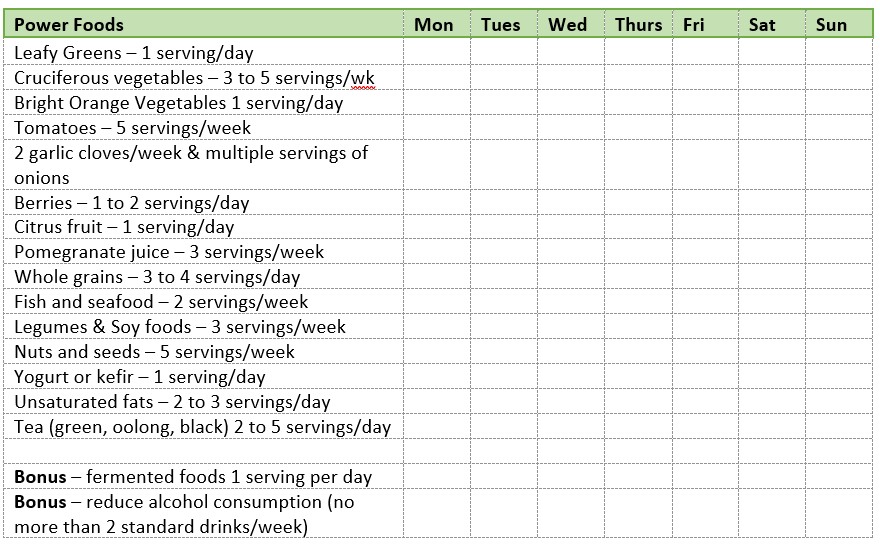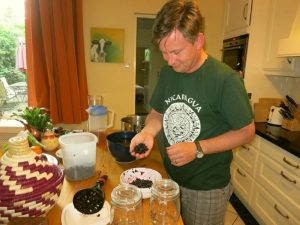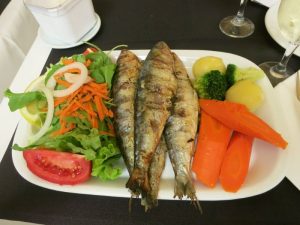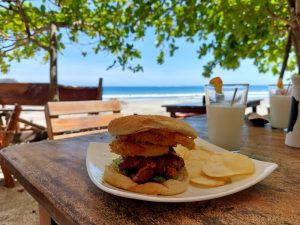What are the Power Foods for Good Health?
I think we are all aware of how nutrition impacts health and longevity. But there are certain power foods that can have more of impact than others.
Power foods are whole foods rich in nutrients and phyto-chemicals that contain no synthetic or artificial additives.
For April, based on a book I read, (Foods That Fight Disease by Leslie Beck RD), I wanted to try to eat more of these power foods.
Beck stated,
“… fighting disease with nutrition is more than just limiting bad foods (high-fat animal foods, refined grains, sugary desserts, heavily processed foods, and fast foods). …when it comes to fighting disease (high blood pressure, cholesterol, dementia, diabetes, etc.) the foods you include in your diet are just as important as the ones you exclude.”
What are the power vegetables to fight disease?
From scientific studies there are certain vegetables that have demonstrated superior health benefits to fight disease.

Popeye the sailor man was right, eating spinach daily is good for you!
From my reading of the book, what I propose to do for this month’s experiment is try to eat the number of servings recommended of the power foods. I have adapted Leslie Beck’s power foods checklist into a chart that I will use.
Since there is so much information, if you wish to know more of the details of ‘why’ these foods were picked, I have included the details after the chart. (Also the serving size is described).
April’s Checklist for Nutrition

1. Eat at Least 1 Serving of Green Leafy Vegetables a Day
Beck states “when it comes to vitamins, minerals, and disease-fighting chemicals, leafy green vegetables are hard to beat”.
Numerous studies have linked higher intakes of leafy green vegetables with a lower risk of cancer, warding off heart attacks and stroke, and promoting eye health. They are also good for your bones due to the high amounts of Vitamin K.
Green Leafy Vegetables might also keep your mind sharp as you age. Scientists attribute this to Vitamin E that is most abundant in these types of vegetables.
Some of the top green leafy vegetables are:
- Kale (1/2 cup of cooked kale packs more than 4 times the amount of your daily Vitamin K, half of the daily Vitamin A, along with generous amounts of vitamin C and potassium all for 18 calories!)
- Spinach
- Swiss Chard

Eating a salad in Paris. (Note: Disregard the wine bottle, 😉 ) - Collard Greens
- Mustard Greens
- Rapini
- Turnip Greens.
These were some of the top ones mentioned, but if none of this strikes your fancy, here are some more:
- Arugula
- Leaf Lettuce
- Romaine lettuce.
Next stop, Cruciferous vegetables! I bet you are getting excited now.
2. Eat 3 to 5 servings of Cruciferous vegetables per week
Now that I look back, my parents were not so bad in making me eat all the vegetables off my plate!
These are vegetables such as broccoli, cauliflower, cabbage, brussels sprouts and turnips. Many of the leafy greens are also cruciferous vegetables (kale, collards, rapini, Swiss chard, etc.)
These types of vegetables have a strikingly high concentration of the cancer fighting chemicals know as glycosylates. They also supply vitamin A, folate, calcium and potassium.
3. Eat even more vegetables with Bright Orange Vegetables at 1 serving a day (1 serving = ½ cup raw or cooked)
It turns out that beta carotene, besides its Vitamin A activity, is also a powerful antioxidant, protecting cells in the body from damage caused by free radicals.
As you would think, carrots are at the top of the list along with sweet potatoes, pumpkins and winter squash.

So, what’s next? Even more vegetables… tomatoes.
4. Eat 5 Servings of Tomatoes per week (1 serving = one medium tomato, ½ cup of juice or 2 tablespoons of

sauce)
The reason tomatoes are so important is that they contain lycopene, an antioxidant that neutralizes free radicals that can interfere with normal cell growth.
Also, cooked tomatoes have more lycopene than raw, as cooking releases more lycopene that can be absorbed by the body.
Tomatoes are an excellent source of vitamins A and C, and they’re a good source of B vitamins and potassium, a mineral that helps regulate blood pressure.
So, are you getting tired of vegetables?
Well, there is one more category! Allium vegetables
Allium vegetables are:
- Garlic
- Onions
- Leeks
- Chives
- Scallions/Shallots
The disease fighting properties of allium vegetables are attributed to a variety of powerful sulphur-containing chemicals. They also contain flavonoids, phytochemicals linked to disease prevention.
Garlic has been studied extensively and a combined analysis of 18 scientific papers concluded people who eat raw or cooked garlic regularly face about half the risk of stomach cancer and 2/3rds the risk of colorectal cancer as people who eat little or none. *
*Fleischauer, AT, C Poole, and L Arab, Garlic consumption and cancer prevention: Meta-analysis of colorectal and stomach cancers. Am J Clin Nutr 2000, 72(4):1047-52
Don’t worry, we are now on to fruits and leaving the vegetables behind!
There are 3 types of fruits that are considered good for you: Berries, Citrus Fruit and Pomegranates
6. Eat 4 fruit servings (2 cups/500 ml of fresh fruit) per day.

From a nutrition standpoint, fruit is pretty tough to beat. Beck states:
“It’s an excellent source of dietary fibre, potassium, vitamin C, and folate, nutrients vital for maintaining good health and guarding against disease. Indeed, a diet rich in colourful, nutrient-dense fruit has been linked to lower rates of cancer, heart disease, stroke, cataract, macular degeneration, and type 2 diabetes. Adding fruit to your diet can also:
- Help control blood pressure and cholesterol,
- Decrease bone loss
- Promote weight loss, and
- Prevent a painful intestinal condition called diverticulitis.”
She also says, there is no need to limit eating fruit for fear of sugar content. Unlike refined sugars found in candy, baked goods, or ice cream, these sugars are naturally occurring and are considered healthy as you also get vitamins, minerals and fibre.
What about fruit juice?
You have to be cautious about portion size and choose juices that are 100% juice to get the most benefit.

Berries (eat 1 to 2 servings per day, ½ cup = 1 serving)
These are labeled super fruits as they are a great sources of vitamin C and dietary fibre along with their strikingly high antioxidant content.
Berries outshine all other fruits for antioxidants!

They are also important for a supply of lutein, a Phyto-chemical that helps guard against cataracts and age-related macular degermation (can cause blindness in older adults).
My Mom has macular degeneration that is under control, but it is concerning! I would like to prevent myself from going down this path!
Citrus Fruits (1 serving per day, medium orange, ½ grapefruit)

Did I say Vitamin C! Which of course builds the immune system. Citrus fruits also generous amounts of folate, potassium and thiamine, as well as some vitamin A, calcium, magnesium, and fibre.
(Note: Grapefruit can interfere with medications used to treat high blood pressure, cholesterol, migraines, depression, anxiety, sleep disorders, etc. Consult your Doctor is you fit these categories.)
Pomegranates (3 servings per week) ½ cup seeds or ½ cup juice
Pomegranate juice contains high levels of antioxidants and the polyphenols may benefit the heart. But please note, this fruit juice can be expensive!
7. Eat whole grains to Reduce Inflammation in Your Body and Provide Fiber (3 servings – ½ cup cooked grain, 2 tablespoons flaxseed, 30 g bread or breakfast cereal)
This category is a little more tricky!
All grains (wheat, rye, oats, or spelt) start out as whole-grain kernels. But when the grains are refined, they can lose a lot of their fiber and nutrients. When the grains are processed the bran and germ are removed and all that’s left behind is the starchy endosperm.
How to Identify Whole Grains in Products
For whole grains such as brown rice, quinoa and oatmeal it is straightforward to find the real deal. But with breads, crackers, and breakfast cereals it is more difficult.
Beck states, “Just because a food has ‘whole grain’ stamped on its package does not mean it’s jam-packed with whole grains.”
The only way to know is to read the label. Look for ‘100% whole grain’ on the package and choose products that list whole grains ‘first” in the ingredient list.
What is the health benefit?
Beck states, “A wealth of scientific evidence show that people who choose whole grains over their refined counterparts have better health outcomes. Studies consistently link a diet rich in whole-grain goods with protection from heart disease, stroke, type 2 diabetes, certain cancers, and obesity.”
What are the grains that are good for you?
- Amaranth
- Barley
- Brown Rice
- Buckwheat
- Flaxseed
- Kamut
- Millet (hulled)
- Oats
- Quinoa
- Rye
- Spelt
- Whole Wheat
- Wild Rice
8. Get your protein from these 3 categories:
- Fish and Seafood (arctic char, clams, haddock, halibut, herring, mackerel, mussels, oysters, rainbow trout, salmon, sardines, scallops, shrimp, squid, striped bass, tilapia)
- Legumes and soy foods (black beans, back-eyed peas, chickpeas, fava beans, kidney beans, lentils, lima beans, navy beans, pinto beans, soybeans, soy beverages, split peas, tempeh, texturized vegetable protein, tofu)
- Nuts and Seeds (almonds, Brazil nuts, cashews, hazelnuts, macadamia nuts, peanuts, peans, pine nuts, pistachios, pumpkin seeks, sesame seeds, sunflower seeds, walnuts).
The author of the book is not emphasizing meat, poultry or eggs as compared to the foods listed as these foods not only have protein but other health benefits from the omega-3fatty acids, soluble fibre and phytochemicals.
Beck says, for meat, choose lean cuts, buy organic and control portion side. (1 serving = 3 ounces). For eggs look for omega-3 eggs.
Fish and Seafood (2 servings per week, 1 serving = 3 ounces)

There’s truth to saying that fish is brain food.

Omega-3 fatty acids in fish are needed for the development and maintenance of the brain, eye, and nervous tissued throughout life.
It is especially important for fighting Alzheimer’s disease and dementia!
In a study that followed 815 adults, age 65-94 years, for almost 4 years revealed that those who ate fish at least once per weeks were 60% less likely to develop Alzheimer’s disease compared with people who rarely or never ate fish.
Should I be concerned about Fish and Mercury?
Yes, with larger fish such as shark, swordfish, and tuna. Health Canada advises to limit your intake to a small portion once per month. This advisory does not include ‘light’ canned tuna, only albacore or white tuna.
Another concern, you may have, when it comes to fish is dioxins (chemical compounds), especially as it relates to salmon.
Yes, there is a cancer risk if you eat farmed salmon more than once a month. But, Beck states, “there is a mountain of evidence that eating fish rich in omega-3 fats protects against heart disease.”
Researchers from Harvard School of Public Health and Medical School evaluated the risks with eating fish and they found the heart benefits outweighed the cancer risks by 100 to 370-fold for farmed salmon and by 300 to 1000-fold for wild salmon. *
*Mozaffarian, D, and EB Rimm. Fish intake, contaminants, and human health; Science 2004, 303(5655):226-29
Cooking methods that allow the fat to cook-off (e.g. baking, broiling, and grilling, versus frying) will lower the amount of PCBs and dioxins in foods.
It is also recommended to buy fish for sustainability.
Legumes and Soy foods (eat 3 servings per week, 1 serving = ¾ cup)
Dried beans, pleas and lentils are nutritional winners. They are low in fat and an excellent source of protein.
The food guide advised Canadians to eat beans, lentils and tofu in place of meat more often to help reduce saturated fat and increase fibre intake.
When it comes to vitamins and minerals, legumes really shine. They are an excellent source of folate (B vitamin) and also provide calcium, magnesium, and potassium, minerals that help prevent high blood pressure.
Soy foods
One review of more than 40 studies noted that eating 25 grams (g) (0.88 oz) of soy protein every day for 6 weeks led to a 3.2% decrease in LDL (bad) cholesterol and a 2.8% decrease in total cholesterol.
What are some examples of Soy foods?

Tofu
Tempeh is made from fermented soybeans that have been pressed into a compact cake.
Natto is a staple probiotic food in traditional Japanese cuisine. Like tempeh, it’s made from fermented soybeans. It has a strong flavor and a slimy texture.
Miso is a common seasoning in Japanese cuisine. It’s made by fermenting soybeans with salt and koji, a type of fungus. It’s most often found in miso soup, a flavorful dish made of miso paste and stock.
Nuts and Seeds (Eat 5 servings per week, 1 serving = ¼ cup nuts or seeds)
Although high in fat, nuts are unusually rich in arginine, an amino acid that may improve flood vessel function. Nuts are also a good source of magnesium, a mineral shown to help maintain a health blood pressure.
But be careful, count your nuts, for calorie intake!
9. Get your calcium and pro-biotics in Yogurt and Kefir (1 serving per day, 1 serving = ¾ cup)
I have tried Kefir and I am not a big fan, but I do eat natural yogurt in the morning.
Probiotics (live bacteria) found in yogurt or kefir can stimulate the immune system, prevent allergies, improve symptoms of lactose intolerance, help treat inflammatory bowel disease and possibly even lower elevated cholesterol levels.
One of the best-known benefits of consuming calcium-rich foods is the prevention of osteoporosis. Osteoporosis affects one in four women over the age of 50.
Keep in mind, that you need not only calcium rich foods to keep your bones healthy, but also:
- Physical activity
- Intake of vitamin D, vitamin K, and magnesium.
NOTE: Recently there have been a lot of studies about the importance of gut health and fermented foods. If you would like to include this in your diet for more probiotics, give it a go. Live cultures are found in not only yogurt and a yogurt-like drink called kefir, but also in Korean pickled vegetables called kimchi, sauerkraut, and in some pickles.
Kombucha is a fermented tea that’s fizzy, tart, and flavorful and is also good for digestion. It’s made from either green or black tea and offers these drinks’ potent health-promoting properties.
10. Power Fats and Oils
The Canada Food Guide advises that we consume 2 to 3 tablespoons of unsaturated fat each day for optimal health. These types of fats promote heart health.
Some options are: Avocados, canola oil, flaxseed oil, olive oil and walnut oil.
11. Drink More Tea (Consume 2 to 5 servings per day)
Although drinking adequate amount of water (9 cups each day) is important, it is also a good idea to consider teas that supply a rich source of phytochemicals.
Drinking green tea regularly has been linked with lower rates of numerous types of cancers, as well as heart disease.
Health Canada has stated all types of tea (black, green, and oolong) are recognized as a source antioxidants for the maintenance of good health.
12. Reduce Alcohol consumption
I must say that I did get used to drinking wine with meals when I lived in the Netherlands. But now it is thought if you drink more then 2 standard drinks per week you are at a higher risk of developing cancer.
The Canadian Centre on Substance Use and Addiction issued Canada’s Guidance on Alcohol and Health, updating its 2011 Low Risk Drinking Guidelines. The new guidance states that no amount of alcohol is safe. It presents a continuum of risk and indicates that the risk of alcohol-related consequences begins to increase when consuming more than two standard drinks per week, which is considered low risk.
I will try my best! I have succeeded in limiting alcohol to the weekends, but I need to reduce even more. (Although to be honest, I was just in Costa Rica for 2 weeks and I must say I had my sunset rum drink each evening. I was traveling with my mother-in-law, 😉 ! Interpret that statement how you would like…)
Well with that note I will sign off. Pura Vida (The (pure) good life) from Coast Rica!

Live well,
Diana
